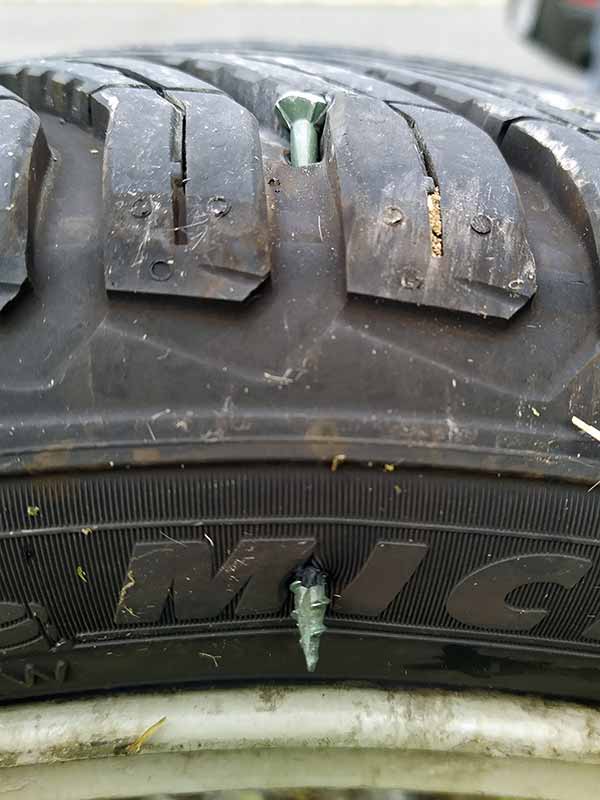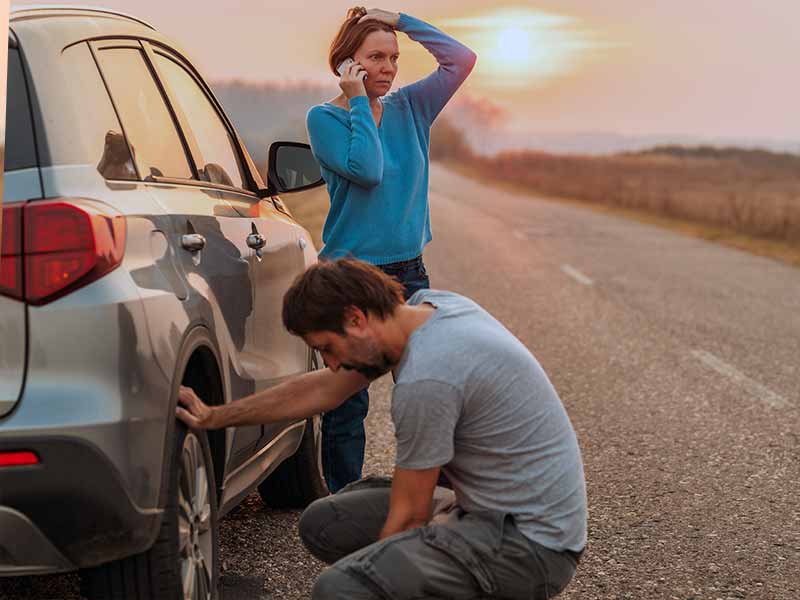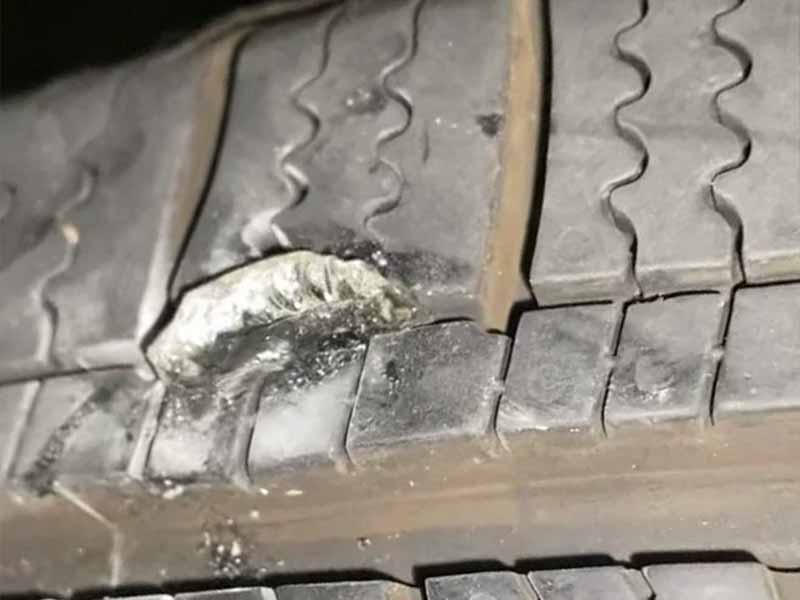Driving over glass is a situation most drivers dread, stirring up visions of punctured tires and costly repairs. But is this fear really warranted? Understanding the actual risks and knowing what to do can change this worry into confident action.
Can Glass Pop A Tire?
No, glass can generally not pop a tire, although it’s not impossible. You usually don’t need to worry if you’ve driven over glass. Modern tires are robustly designed to handle common road hazards like broken glass, and the chances of getting a flat tire from glass are relatively low.
In this article, we will cover the immediate actions you should take after driving over glass, how to inspect your tires for damage, and why tire pressure is crucial. We will also discuss various real-world scenarios involving glass and tires, along with best practices to keep your tires safe.
Let’s take a closer look.
Should You Worry If You’ve Driven Over Glass?
You’ve just driven over a patch of broken glass, and now you’re worried about your tires. Is your concern justified? Let’s examine when you should worry and what steps you can take to ensure your tires are in good shape.
Immediate Actions
- Don’t Brake Abruptly: If you’ve just run over glass, avoid slamming on the brakes. Abrupt stopping could lodge the glass deeper into your tires.
- Pull Over Safely: Instead, pull over to a safe location, away from the flow of traffic. Turn on your hazard lights.
Inspecting Your Tires
- Visual Check: Get out of the car and inspect your tires. Look for large pieces of glass that might have lodged into the tread.
- Feeling and Listening: Run your hand carefully over the surface to feel for any protrusions. Listen for any hissing sounds that indicate air is escaping.
Using Your Tire Pressure Gauge
- Check Pressure: Use your tire pressure gauge to check if the pressure has dropped. A significant drop could indicate a puncture.
- Compare to Optimal Levels: Compare the readings with the recommended tire pressure levels for your car, usually found in the owner’s manual or on a sticker in the driver’s door jam.
What to Do If You Find an Issue
- Small Puncture: If you discover a small puncture but the tire isn’t rapidly losing air, you can use a tire repair kit as a temporary fix until you can visit a professional.
- Large Puncture or Rapid Air Loss: If the tire is losing air rapidly, replace it with the spare tire and consult a professional for repair or replacement.
When Not to Worry
- No Visible Damage: If after all these checks, you find no evidence of a puncture or air loss, and the pressure is stable, there is generally no reason to worry.
- Why Robust Tires Help: Remember, modern tires with steel belts are robustly built to handle common road hazards like broken glass.
While driving over glass can make any driver nervous, understanding how to inspect your tire and when to seek professional help can provide peace of mind. Most times, thanks to the sturdy construction of today’s car tires, driving over glass is a low-risk event.

What Can Puncture a Tire?
Knowing what could potentially puncture a tire is vital for every driver. Despite the robust design of tires, some materials and objects can still cause damage. Let’s delve into what you should be cautious of when on the road.
Common Puncture Culprits
- Metal Objects: Things like nails and screws are among the most common items that can puncture a tire. These objects have sharp points that can easily penetrate the rubber.
- Sharp Rocks: Although uncommon, a particularly sharp or jagged rock can also cause a puncture if you run over it at high speeds.
- Other Debris: Sometimes, less obvious things like a piece of bone or hard plastic can also pose a risk, especially if it has sharp edges.
Is Glass a Common Culprit?
- Not Really: Contrary to popular belief, glass is generally not a frequent cause of flat tires.
- Reasons: There are several reasons for this.
- Glass is usually brittle and breaks under pressure, making it less likely to puncture the tire’s rubber.
- The steel belts inside the tire often provide enough protection to prevent a glass puncture.
- Most glass shards on the road are flat, lacking the pointed shape needed to penetrate the tire.
How Tires Resist Glass
- Steel Belts: As we learned in the previous section, the steel belts in the tire add an extra layer of protection. They are designed to block objects from penetrating through the rubber.
- Rubber Flexibility: The rubber in tires is flexible, allowing it to absorb and dissipate the force of running over objects like glass, reducing the risk of puncture.
Factors That Make Tires Vulnerable
- Low Pressure: A tire that is not properly inflated is more susceptible to punctures from all kinds of objects, including glass.
- Worn-out Tires: Old or worn-out tires have less effective tread and may also have weakened steel belts, making them more vulnerable to punctures.
- High Speeds: Driving at high speeds increases the force of impact between the tire and any object on the road, making punctures more likely.

Real-World Scenarios Involving Glass
Navigating through roads often exposes your tires to various objects, and broken glass is a common one. Let’s explore what actually happens when your car tires encounter glass in different scenarios and how much you should worry.
Driving Over a Glass Bottle
- Impact on Tire: The idea of driving over a glass bottle sounds concerning, but it’s generally not a problem for your tire. The bottle is more likely to shatter under the weight and pressure.
- But Be Cautious: However, if the bottle breaks in a way that leaves sharp, pointing shards, there is a slight chance it could pierce your tire, although this is rare.
Parking on Broken Glass
- Low Risk: Parking your car on broken glass generally doesn’t lead to immediate punctures. The glass is more likely to move aside or further break under the tire’s weight.
- Check Before Moving: Before you drive away, it’s a good idea to remove any large pieces of glass that might be under the tire to reduce the risk of them getting lodged in the tread.
Running Over Shattered Glass in a Parking Lot
- Common Scenario: This is probably the most common way cars come in contact with broken glass. You’re driving through a parking lot and roll right over a patch of shattered glass.
- Generally Safe: The dispersed pieces of glass usually don’t have the shape or strength to puncture a tire. Most likely, they’ll just get pushed aside.
- Post-Drive Check: However, it’s advisable to inspect your tires afterward to make sure no pieces of glass are stuck in the tread.
What if You Find Glass Stuck in the Tire?
- Don’t Panic: Finding a piece of glass stuck in your tire’s tread is not a reason to panic. Most times, it’s lodged superficially and hasn’t penetrated through to cause a leak.
- Removal Steps: Use pliers to carefully remove the glass. After removal, check for leaks by listening for a hissing sound or using a pressure gauge to ensure the pressure hasn’t dropped.
In these real-world scenarios, encountering broken glass while driving or parking is generally low-risk due to the robust construction of modern tires. It’s always good to exercise caution by checking your tires and removing any debris that could, over time, cause an issue.

Best Practices to Avoid Tire Damage
You never know what you might encounter on the road, but there are some best practices to keep your car tires in top shape and reduce the chance of getting a flat tire. Here, we’ll focus on how to avoid driving over glass, the importance of keeping your tires properly inflated, and why an emergency tire repair kit is a must-have.
Tips to Avoid Driving Over Glass
- Stay Alert: Always keep your eyes on the road. This simple practice can help you spot any glass or other debris and steer clear before your car tires run over them.
- Avoid Side of Road: Debris, including broken glass, often accumulates at the sides of roads. Stick to the middle lanes when possible.
- Be Extra Cautious in Parking Lots: Places like parking lots or side streets are common spots for broken glass. Drive slowly and carefully in these areas to give you more time to avoid hazards.
Importance of Properly Inflated Tires
- Why It Matters: Maintaining the right air pressure in your car tire is critical for the durability and performance of your tires.
- Use a Tire Pressure Gauge: Regularly check the air pressure with a tire pressure gauge to ensure it’s within the recommended range. Correct air pressure can prevent a flat tire and even save you money on fuel.
- What Happens If You Don’t: Under-inflated or over-inflated tires are more susceptible to damage, not just from glass but from potholes, nails, and other road hazards.
Keeping an Emergency Tire Repair Kit
- Essentials to Include: Your emergency tire repair kit should have at least a tire sealant, an inflator, and a pressure gauge.
- Quick Fixes: In case you do end up with a puncture, a repair kit can serve as a quick fix to get you to the nearest service station.
- Know How to Use It: Take some time to familiarize yourself with the items in your emergency kit. The knowledge could be invaluable in stressful situations.
Resources
Below are some links you may find helpful when learning about tires
Final Thoughts
The truth is, driving over glass usually isn’t as concerning as it initially seems, thanks to the durable construction of modern car tires. However, being proactive can go a long way in ensuring your tires stay in good shape. Always perform regular checks using a pressure gauge, steer clear of road debris, and keep an emergency tire repair kit in your car for unforeseen incidents.
Good luck and happy motoring.





